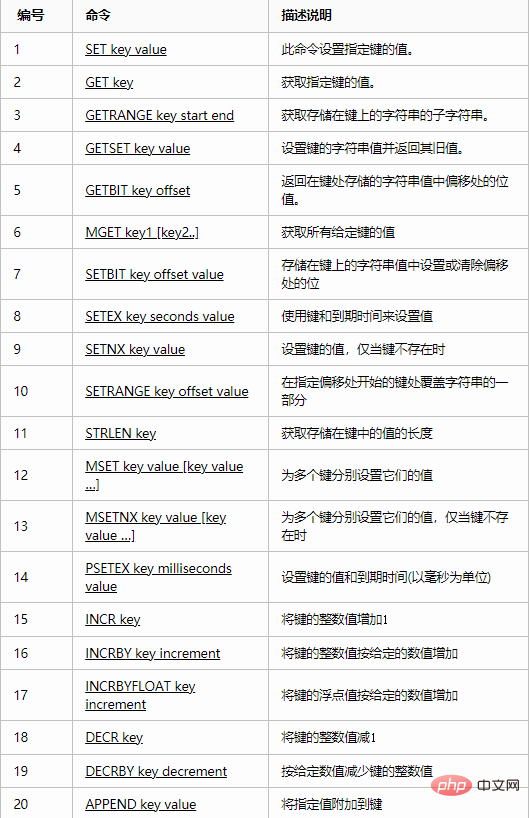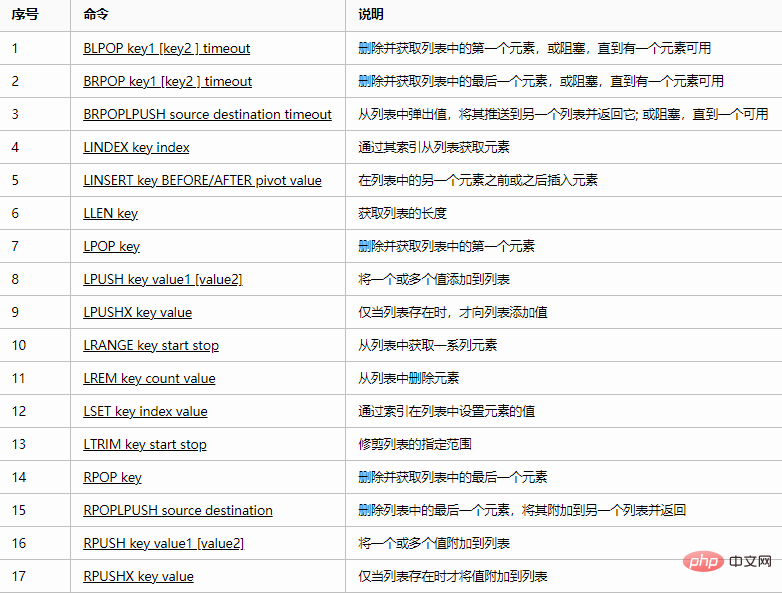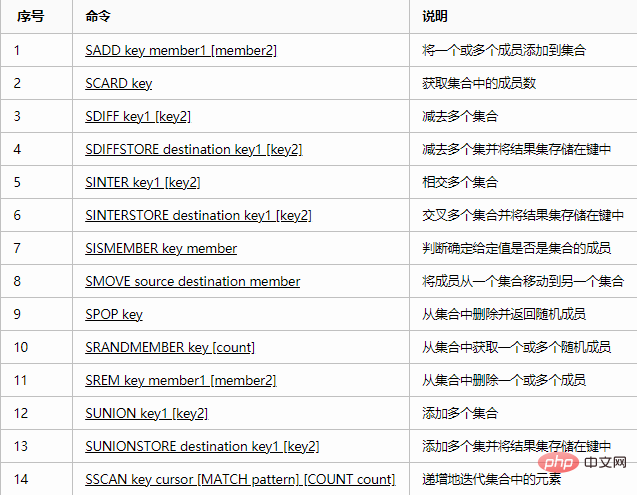What are the usages of the five types in redis

First of all, let’s introduce the five types in redis:
String, Hash/Hash/Dictionary (Hash), List ), collection (Set), ordered set (sorted set).
Controller:@Resource RedisTemplate
Summary:
redisTemplate.opsForValue();//Operation string
redisTemplate .opsForHash();//Operation hash
redisTemplate.opsForList();//Operation list
redisTemplate.opsForSet();//Operation set
redisTemplate.opsForZSet();//Operation ordered set
String:
1.redisTemplate.opsForValue().set(key,value));
2.redisTemplate.opsForValue().get(key));
3.redisTemplate.opsForValue().get(key, start, end);
4.redisTemplate.opsForValue().getAndSet(key, value);
5.redisTemplate.opsForValue().getBit(key, offset);//Comments below
6.redisTemplate.opsForValue().multiGet(keys);
7.redisTemplate.opsForValue().setBit(key, offset, value);//Comments below
8.redisTemplate.opsForValue().set(K key, V value, long timeout, TimeUnit unit);//TimeUnit is the type of timeout, such as milliseconds\seconds\days, etc.
9.redisTemplate.opsForValue().setIfAbsent (key, value);
10.redisTemplate.opsForValue().set(K key, V value, long offset);//The blogger did not do java verification here
11.redisTemplate.opsForValue(). size(key));
12.redisTemplate.opsForValue().multiGet(Collection
13.redisTemplate.opsForValue().multiSetIfAbsent(Map extends K, ? extends V> m );
14. Same as 8
15\16\17\18\19.redisTemplate.opsForValue().increment(K key, long delta); or .increment(K key, double delta);
20.redisTemplate.opsForValue().append(key, value);//Append the value value to the right of the value corresponding to the key key
You can see that there is no deletion method. The blogger has studied it and it can be like this: 21. del key------21.redisTemplate.opsForValue().getOperations().delete(key);

.getBit(key, offset): Get the offset value of the ASCII code corresponding to the key.
@ascii code comparison table

1.redisTemplate.opsForHash().delete(H key, Object... hashKeys);//... means multiple maps can be passed in The keys are separated by . Or use an array to pass the value
2.redisTemplate.opsForHash().hasKey(key, hashKey);
3.redisTemplate.opsForHash().get(key, hashKey);
4.redisTemplate.opsForHash( ).entries(key);//Return map collection
5, 6.redisTemplate.opsForHash().increment(H key, HK hashKey, long delta);//or increment(H key, HK hashKey, double delta );;
7.redisTemplate.opsForHash().keys(key);//Return the map key collection Set
8.redisTemplate.opsForHash().size(key);
9.redisTemplate. opsForHash().multiGet(H key, Collection
10.redisTemplate.opsForHash().putAll(H key, Map extends HK, ? extends HV> m);
11. redisTemplate.opsForHash().put(key, hashKey, value);
12.redisTemplate.opsForHash().putIfAbsent(key, hashKey, value);
13.redisTemplate.opsForHash().values(key) ;//Return the value collection List in the map;

redisTemplate.opsForList().leftPush(key, value);//From Store and push the stack from left to right
redisTemplate.opsForList().leftPop(key);//Pop the stack from the left
redisTemplate.opsForList().size(key);//Team/stack length
redisTemplate .opsForList().range(key, start, end);//Range retrieval, return List
redisTemplate.opsForList().remove(key, i, value);//Remove the i whose value is value in key , returns the number of deleted elements; if there is no such element, returns 0
redisTemplate.opsForList().index(key, index);//Retrieval
redisTemplate.opsForList().set(key, index, value );//Assignment
redisTemplate.opsForList().trim(key, start, end);//Crop, void, delete all elements except [start, end]
redisTemplate.opsForList().rightPopAndLeftPush (String sourceKey, String destinationKey);//Delete a value on the right side of the source key queue, then insert it into the left side of the target key queue, and return this value
Note: The object to be cached must implement the Serializable interface, because Spring will serialize the object first and then store it in Redis, otherwise a nested exception is java.lang.IllegalArgumentException: DefaultSerializer requires a Serializable……//;;/

Set:
redisTemplate.opsForValue().getAndSet(key, value)
The above is the detailed content of What are the usages of the five types in redis. For more information, please follow other related articles on the PHP Chinese website!

Hot AI Tools

Undresser.AI Undress
AI-powered app for creating realistic nude photos

AI Clothes Remover
Online AI tool for removing clothes from photos.

Undress AI Tool
Undress images for free

Clothoff.io
AI clothes remover

Video Face Swap
Swap faces in any video effortlessly with our completely free AI face swap tool!

Hot Article

Hot Tools

Notepad++7.3.1
Easy-to-use and free code editor

SublimeText3 Chinese version
Chinese version, very easy to use

Zend Studio 13.0.1
Powerful PHP integrated development environment

Dreamweaver CS6
Visual web development tools

SublimeText3 Mac version
God-level code editing software (SublimeText3)

Hot Topics
 1386
1386
 52
52
 How to build the redis cluster mode
Apr 10, 2025 pm 10:15 PM
How to build the redis cluster mode
Apr 10, 2025 pm 10:15 PM
Redis cluster mode deploys Redis instances to multiple servers through sharding, improving scalability and availability. The construction steps are as follows: Create odd Redis instances with different ports; Create 3 sentinel instances, monitor Redis instances and failover; configure sentinel configuration files, add monitoring Redis instance information and failover settings; configure Redis instance configuration files, enable cluster mode and specify the cluster information file path; create nodes.conf file, containing information of each Redis instance; start the cluster, execute the create command to create a cluster and specify the number of replicas; log in to the cluster to execute the CLUSTER INFO command to verify the cluster status; make
 How to clear redis data
Apr 10, 2025 pm 10:06 PM
How to clear redis data
Apr 10, 2025 pm 10:06 PM
How to clear Redis data: Use the FLUSHALL command to clear all key values. Use the FLUSHDB command to clear the key value of the currently selected database. Use SELECT to switch databases, and then use FLUSHDB to clear multiple databases. Use the DEL command to delete a specific key. Use the redis-cli tool to clear the data.
 How to read redis queue
Apr 10, 2025 pm 10:12 PM
How to read redis queue
Apr 10, 2025 pm 10:12 PM
To read a queue from Redis, you need to get the queue name, read the elements using the LPOP command, and process the empty queue. The specific steps are as follows: Get the queue name: name it with the prefix of "queue:" such as "queue:my-queue". Use the LPOP command: Eject the element from the head of the queue and return its value, such as LPOP queue:my-queue. Processing empty queues: If the queue is empty, LPOP returns nil, and you can check whether the queue exists before reading the element.
 How to use the redis command
Apr 10, 2025 pm 08:45 PM
How to use the redis command
Apr 10, 2025 pm 08:45 PM
Using the Redis directive requires the following steps: Open the Redis client. Enter the command (verb key value). Provides the required parameters (varies from instruction to instruction). Press Enter to execute the command. Redis returns a response indicating the result of the operation (usually OK or -ERR).
 How to use redis lock
Apr 10, 2025 pm 08:39 PM
How to use redis lock
Apr 10, 2025 pm 08:39 PM
Using Redis to lock operations requires obtaining the lock through the SETNX command, and then using the EXPIRE command to set the expiration time. The specific steps are: (1) Use the SETNX command to try to set a key-value pair; (2) Use the EXPIRE command to set the expiration time for the lock; (3) Use the DEL command to delete the lock when the lock is no longer needed.
 How to read the source code of redis
Apr 10, 2025 pm 08:27 PM
How to read the source code of redis
Apr 10, 2025 pm 08:27 PM
The best way to understand Redis source code is to go step by step: get familiar with the basics of Redis. Select a specific module or function as the starting point. Start with the entry point of the module or function and view the code line by line. View the code through the function call chain. Be familiar with the underlying data structures used by Redis. Identify the algorithm used by Redis.
 How to solve data loss with redis
Apr 10, 2025 pm 08:24 PM
How to solve data loss with redis
Apr 10, 2025 pm 08:24 PM
Redis data loss causes include memory failures, power outages, human errors, and hardware failures. The solutions are: 1. Store data to disk with RDB or AOF persistence; 2. Copy to multiple servers for high availability; 3. HA with Redis Sentinel or Redis Cluster; 4. Create snapshots to back up data; 5. Implement best practices such as persistence, replication, snapshots, monitoring, and security measures.
 How to use the redis command line
Apr 10, 2025 pm 10:18 PM
How to use the redis command line
Apr 10, 2025 pm 10:18 PM
Use the Redis command line tool (redis-cli) to manage and operate Redis through the following steps: Connect to the server, specify the address and port. Send commands to the server using the command name and parameters. Use the HELP command to view help information for a specific command. Use the QUIT command to exit the command line tool.




